This Wednesday, Dave Weaver and I were not worried about having a great time birding. The action at Scotland Road has not abated, and there was more sun than last week. Unsurprisingly, a bigger group accumulated; they were not disappointed! On the way through Newbury, we could hear many familiar backyard birds announcing that they’re ready for the breeding season. The action began with a couple of Ring-necked Ducks visible on the beaver pond across from the Colby Farm. At the wet meadows of the Common Pasture, things kicked into high gear. The flock of Glossy Ibises we’ve been seeing there was feeding a long way from the platform, but the gang of wigeons and Green-winged Teals swam nearby in the shallow pond near the pull-off. The Eurasian Wigeon pranced about in the morning light, appearing happily aware of his superstardom. Careful searching for Wilson’s Snipes revealed first two, then more and more, as we spent a good long time enjoying finding them and watching the beautiful ducks.

Eurasian Wigeon at Common Pasture – David Moon
Just when we were getting ready to go through some contortions to get a better view of the faraway ibises, a Cooper’s Hawk came bolting in and grabbed a teal! She (we assumed a female because of her size) managed to get her prey into the field toward the back, where some of our group observed her mantling her meal. We assume she did not want to begin eating out there, because after a while she took off toward Scotland Road, still clutching the duck. Barely able to carry her heavy prey, she landed unceremoniously several times, resting each time before making another dash for the trees. Our favorite stop of hers was in front of us, in the shallow pond, where she maintained an air of fierce defiance in the face of her clownish predicament, and where the ducks serenely paddled by her, confident she posed no further threat.
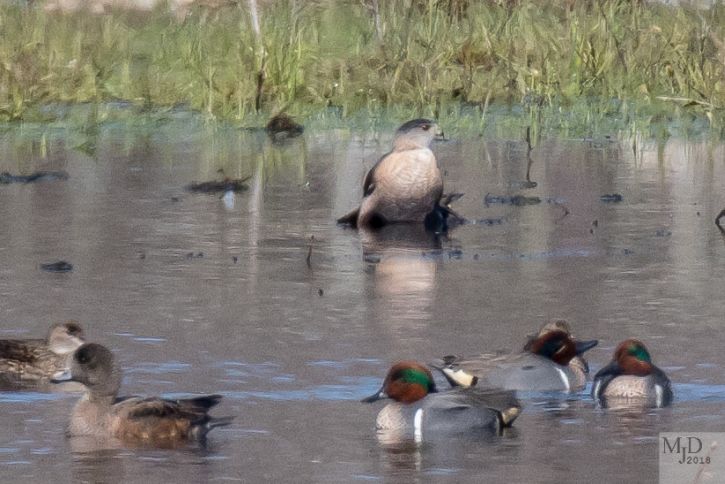
Cooper’s Hawk with prey in water – Mike Densmore
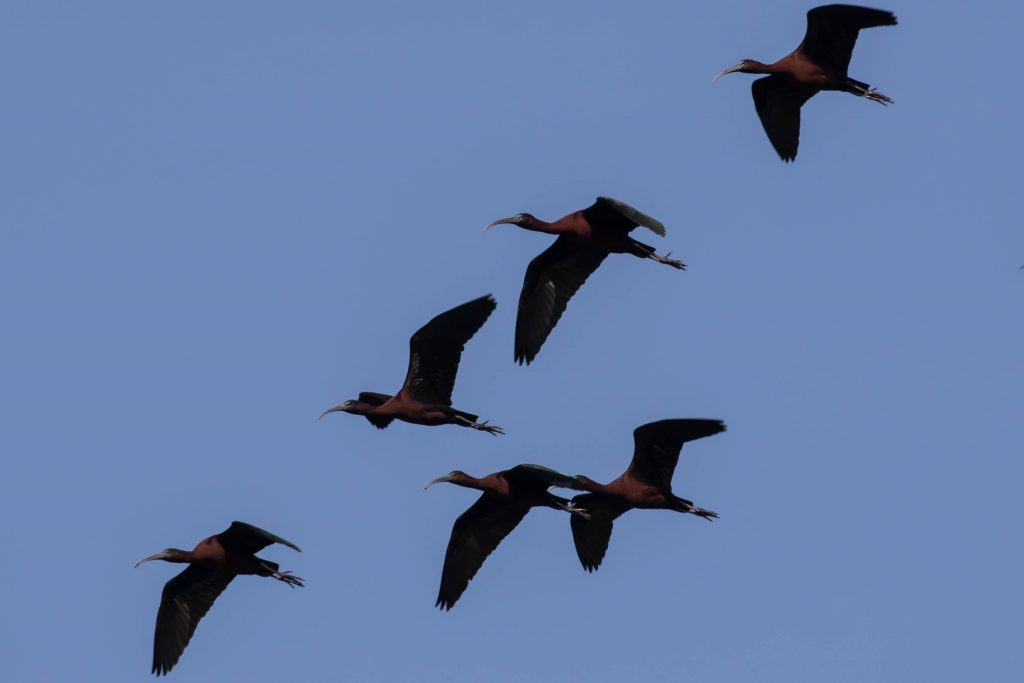
Glossy Ibises come in to roost – David Moon
On the last leg of the hawk’s journey, toward a more private dining area, the duck smacked right into a branch, ending that attempt for a safe landing. To put a cherry on top of the spectacle, the hawk’s initial approach seemed to have put up the distant ibises, who circled around the area and settled just in front of the waterfowl parade.
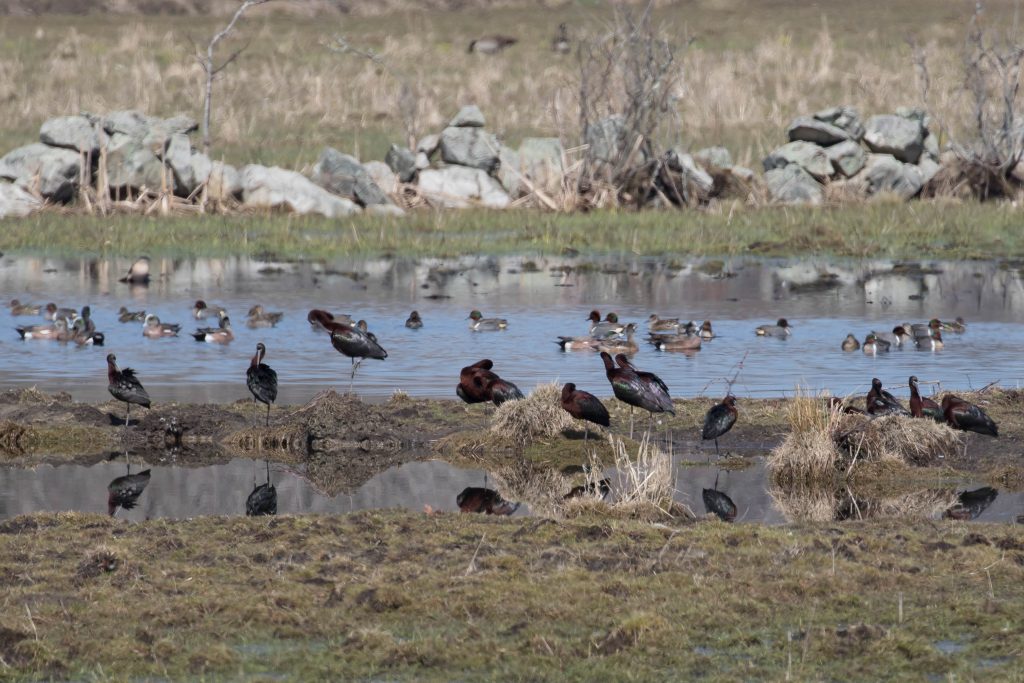
Ibises and waterfowl at Common Pasture – David Moon. Find the predator!
It’s great to hear people murmuring “worth the price of admission right there!” in the beginning of our outing, but we had much more to see. As we entered Parker River NWR on Plum Island, a perfect male Northern Harrier whisked by us on a foray along the edge of the salt marsh. At parking lot #1, the sea looked calm and rather empty. A plover warden sat by the massive beach closure signs, wrapped in blankets from head to toe. Was that a living person or a decoy? No plovers appeared there, but after patient searching of the sea, we spied a scattering of all three scoter species, both Common and Red-throated Loons, and a Horned Grebe in breeding plumage.
We only barely paused to roll slowly by two pairs of Gadwalls and a few American Black Ducks on the salt pannes, where we also spotted at least one Killdeer. We were hurrying to North Pool to enjoy the flock of Northern Shovelers, which was indeed waiting along with a pair of Buffleheads. Another younger male harrier foraged out over North Field (the vegetation succeeding toward a more appropriate name of “North Thicket”), and a young Bald Eagle flew directly over us. We didn’t expect much at the dike at Hellcat, but since we really needed the facilities there, we did find only a few more ducks on the pool. One of the “Pines Platform” Ospreys stood on the pole near the nest in the distance. House Finches and Song Sparrows sang, and we mused about the vast change in avifauna that one month will bring to Hellcat Swamp.
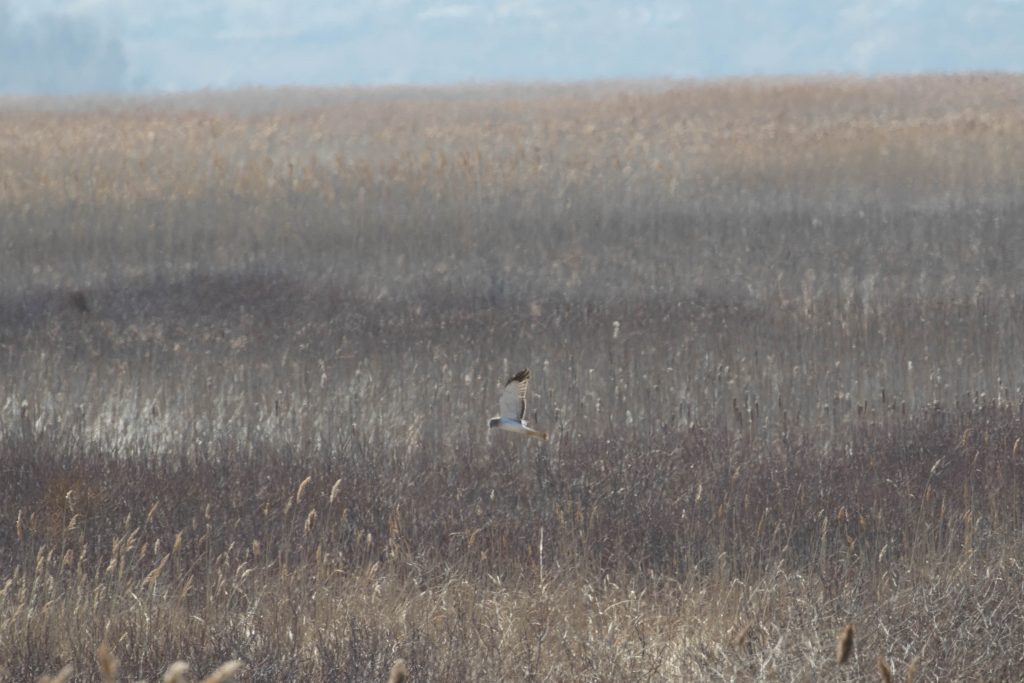
Northern Harrier over North Marsh – David Moon
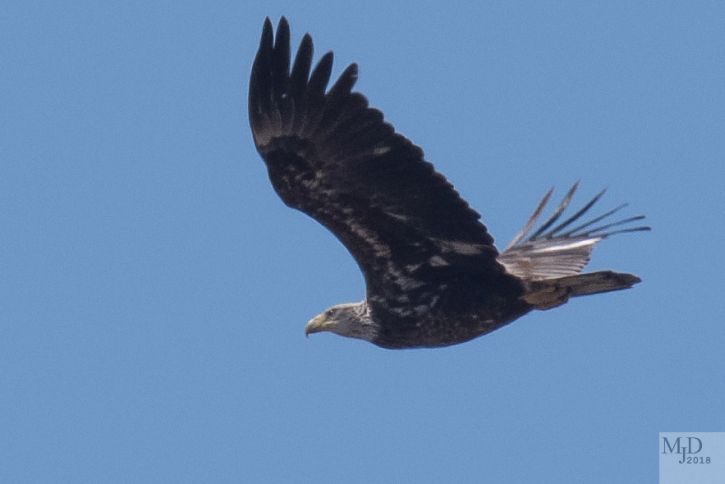
Bald Eagle immature – Mike Densmorel
With not much time, but maybe just enough to spare, we made a dash for the south end of the island. Because parking lot #7 is closed due to storm damage to the beach platform, and thinking that the Bar Head lot was too full, I instructed the caravan to proceed very slowly down the amazing stretch of potholes guarding the last parking lot. My Prius had made it through there unscathed the day before, so…. The spottily traumatized group walked out to the mouth of Plum Island Sound, finding a new landscape dumped there by March’s tempests. A very large area is roped off for plovers and Least Terns. The strong sun heated the exposed sand flats to put up an eerie mist that swirled in the chilly breeze. Ghostly Piping Plovers came in and out of view on the flats further in the sound, and we stared at them for a while to allow some of our group to add the bird to their life lists.

Great Blue Heron in South Marsh – Mike Densmore
What a glorious place we inhabit here on the North Shore, with an ever-shifting scene of magnificent birds, in one place one week, and somewhere else the next. Make sure you get down here this spring, or at least get out somewhere, to revitalize your soul with visions of birds and growing things. Thus comes the impetus to hatch plans to make sure they are all safe for another year, and forever.
Our list:
Scotland Road —
Canada Goose
Eurasian Wigeon (1)
American Wigeon (~ 30)
American Black Duck (2) – pr.
Green-winged Teal (~ 30)
Ring-necked Duck (2) – pond at jct. of Scotland Rd. & Highfield St.
Great Egret (1)
Glossy Ibis (11)
Turkey Vulture (2)
Cooper’s Hawk (1)
Wilson’s Snipe (5) – no doubt there were more.
Blue Jay (2)
American Crow (5)
Black-capped Chickadee (1)
Tufted Titmouse (1)
American Robin – common.
European Starling
Song Sparrow – common.
Northern Cardinal (~ 5)
Red-winged Blackbird – common.
Common Grackle
Plum Island —
Brant (~ 15) – Sandy Point.
Canada Goose – common.
Mute Swan (2)
Gadwall (6)
American Black Duck (4)
Mallard – a few.
Northern Shoveler (10) – North Pool Overlook.
Surf Scoter (1) – one ocean.
White-winged Scoter (~ 6) – parking lot # 1 – ocean.
Black Scoter (2) – parking lot # 1 – ocean.
Long-tailed Duck (~ 20) – parking lot # 1 – ocean.
Bufflehead (4) – 2, NPO; 2, Bill Forward Pool.
Red-breasted Merganser (5) – various.
Red-throated Loon (3) – parking lot # 1 – ocean.
Common Loon (2) – parking lot # 1 – ocean.
Horned Grebe (1) – parking lot # 1 – ocean.
Great Blue Heron (2)
Great Egret (~ 15)
Osprey (1) – Pines platform.
Bald Eagle (1) – 3rd yr., flyover, North Pool Overlook.
Northern Harrier (3) – 2 males, 1 female.
Red-tailed Hawk (1)
Piping Plover (~ 17) – Sandy Point.
Killdeer (2) – salt pannes.
Herring Gull
Black-backed Gull
Rock Pigeon
Mourning Dove
Tree Swallow(2) – salt pannes.
American Robin – common.
Northern Mockingbird (2) – Sandy Point.
European Starling
Song Sparrow – common.
Dark-eyed Junco (2) – S-curves.
Red-winged Blackbird – common.
Common Grackle
House Finch (3) – Hellcat parking area.
American Goldfinch (1) – flyover parking lot #1.
House Sparrow

